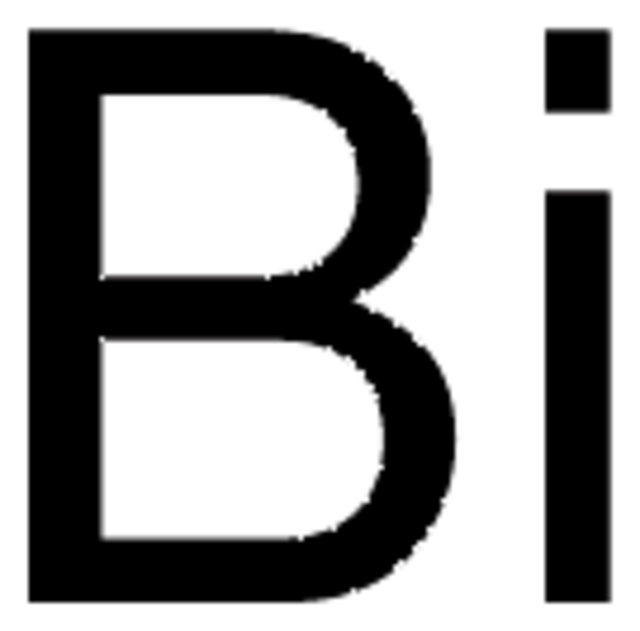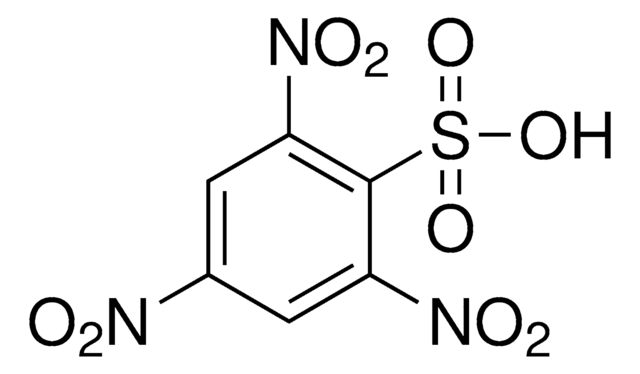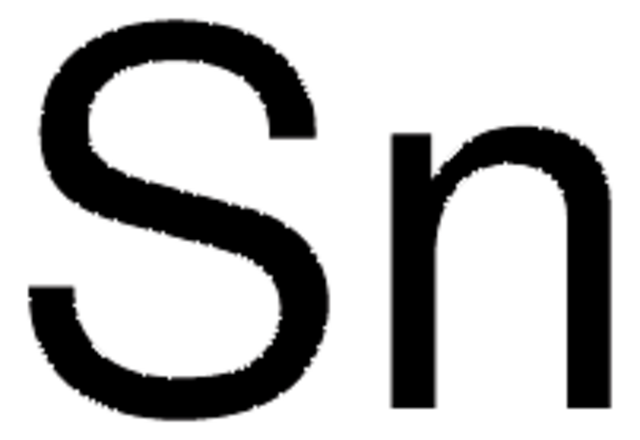95372
Bismuth
granular, ≥99.99% trace metals basis
Sinónimos:
Bi
Iniciar sesiónpara Ver la Fijación de precios por contrato y de la organización
About This Item
Fórmula empírica (notación de Hill):
Bi
Número de CAS:
Peso molecular:
208.98
Número CE:
Número MDL:
Código UNSPSC:
12161600
ID de la sustancia en PubChem:
NACRES:
NA.22
Productos recomendados
presión de vapor
<0.1 mmHg ( 20 °C)
Nivel de calidad
Análisis
≥99.99% trace metals basis
formulario
granular
idoneidad de la reacción
core: bismuth
reagent type: catalyst
resistividad
129 μΩ-cm, 20°C
bp
1560 °C (lit.)
mp
271 °C (lit.)
272 °C
densidad
9.8 g/mL at 25 °C (lit.)
cadena SMILES
[Bi]
InChI
1S/Bi
Clave InChI
JCXGWMGPZLAOME-UHFFFAOYSA-N
¿Está buscando productos similares? Visita Guía de comparación de productos
Categorías relacionadas
Descripción general
Bismuth is a silvery, very brittle metal with a high metallic luster. In the periodic table, it is next to lead. Bismuth has a variety of applications, including medicine, materials synthesis, organic synthesis, and catalysis . It is used in the production of malleable iron and as a catalyst in the manufacture of acrylic fibers . Additionally, bismuth promotes noble metal-based catalysts for the selective oxidation of alcohols, aldehydes and carbohydrates with molecular oxygen in liquid phases.
Aplicación
Bismuth granules are used in the preparation of bismuth nanoparticles by solution dispersion method. It is a precursor to synthesize bismuth-silicate glasses.
Bismuth is used as a precursor in the synthesis of Cu3BiS3 based solar device.
Código de clase de almacenamiento
11 - Combustible Solids
Clase de riesgo para el agua (WGK)
nwg
Punto de inflamabilidad (°F)
Not applicable
Punto de inflamabilidad (°C)
Not applicable
Equipo de protección personal
Eyeshields, Gloves, type N95 (US)
Elija entre una de las versiones más recientes:
¿Ya tiene este producto?
Encuentre la documentación para los productos que ha comprado recientemente en la Biblioteca de documentos.
Los clientes también vieron
Modification of carbon screen-printed electrodes by adsorption of chemically synthesized Bi nanoparticles for the voltammetric stripping detection of Zn (II), Cd (II) and Pb (II).
Rico MAG, et al.
Talanta, 80(2), 631-635 (2009)
A simple way to prepare bismuth nanoparticles.
Zhao Y, et al.
Materials Letters, 58(5), 790-793 (2004)
The role of bismuth in the SOHIO process
Hanna TA
Coordination Chemistry Reviews, 248(5-6), 429-440 (2004)
Characterization of structural, thermal and mechanical properties of bismuth silicate glasses.
Bochentyn B, et al.
Journal of Non-Crystalline Solids, 439(2), 51-56 (2016)
B Arnaud et al.
Physical review letters, 110(1), 016405-016405 (2013-02-07)
By means of first principles calculations, we compute the effective electron-phonon coupling constant G(0) governing the electron cooling in photoexcited bismuth. G(0) strongly increases as a function of electron temperature, which can be traced back to the semimetallic nature of
Nuestro equipo de científicos tiene experiencia en todas las áreas de investigación: Ciencias de la vida, Ciencia de los materiales, Síntesis química, Cromatografía, Analítica y muchas otras.
Póngase en contacto con el Servicio técnico





